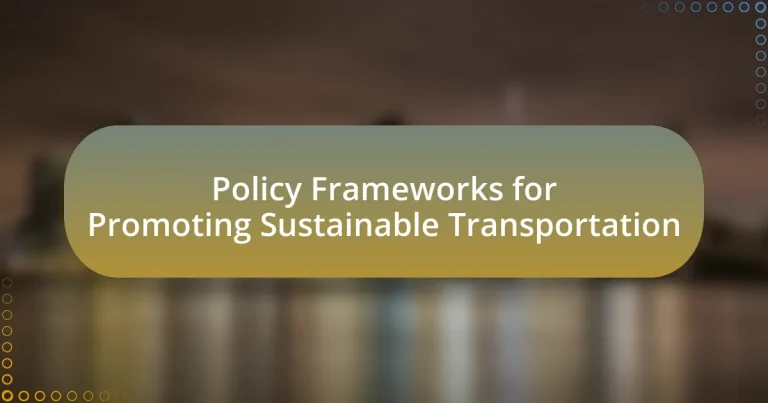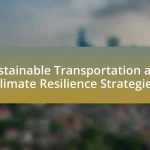Policy frameworks for promoting sustainable transportation are structured guidelines and regulations aimed at fostering environmentally friendly transport systems. These frameworks encompass various components, including emissions reduction targets, incentives for electric vehicle adoption, public transit investment, and support for non-motorized transport options. The article explores how these frameworks influence transportation systems, the key components involved, and their essential role in sustainable development. It also examines the impact of regulatory and financial policies on transportation behavior, the involvement of stakeholders in policy formulation, and best practices for effective implementation. Through case studies and data-driven insights, the article highlights the significance of these frameworks in reducing carbon emissions and promoting economic growth and social equity.

What are Policy Frameworks for Promoting Sustainable Transportation?
Policy frameworks for promoting sustainable transportation are structured guidelines and regulations designed to encourage environmentally friendly transport systems. These frameworks typically include policies such as emissions reduction targets, incentives for electric vehicle adoption, investment in public transit infrastructure, and promotion of non-motorized transport options like cycling and walking. For instance, the European Union’s Green Deal aims to reduce greenhouse gas emissions from transport by 90% by 2050, demonstrating a commitment to sustainable practices. Additionally, cities implementing congestion pricing, like London, have seen reduced traffic and improved air quality, showcasing the effectiveness of such frameworks in achieving sustainability goals.
How do these frameworks influence transportation systems?
Policy frameworks for promoting sustainable transportation significantly influence transportation systems by establishing guidelines and regulations that prioritize environmental sustainability, efficiency, and equity. These frameworks often include measures such as emissions standards, funding for public transit, and incentives for electric vehicles, which collectively drive the adoption of cleaner technologies and practices. For instance, the European Union’s Green Deal aims to reduce greenhouse gas emissions from transport by 90% by 2050, influencing member states to implement policies that support this goal. Additionally, research from the International Transport Forum indicates that effective policy frameworks can lead to a 30% reduction in transport-related emissions when combined with investments in sustainable infrastructure.
What key components are included in these policy frameworks?
Key components included in policy frameworks for promoting sustainable transportation are regulatory measures, financial incentives, infrastructure development, and public engagement strategies. Regulatory measures establish standards for emissions and fuel efficiency, while financial incentives encourage the adoption of clean technologies through subsidies or tax breaks. Infrastructure development focuses on creating efficient public transit systems and cycling paths to support sustainable modes of transport. Public engagement strategies aim to raise awareness and encourage community participation in sustainable transportation initiatives. These components collectively contribute to the effectiveness of policy frameworks in achieving sustainability goals in transportation.
How do these components interact to promote sustainability?
The components of policy frameworks for promoting sustainable transportation interact by establishing regulations, incentives, and infrastructure that collectively encourage environmentally friendly practices. Regulations set standards for emissions and fuel efficiency, while incentives, such as tax breaks or subsidies, motivate individuals and businesses to adopt sustainable technologies. Infrastructure investments, like public transit systems and bike lanes, facilitate the use of alternative transportation modes. Together, these elements create a cohesive system that reduces reliance on fossil fuels, lowers greenhouse gas emissions, and enhances urban mobility, ultimately contributing to sustainability goals. For instance, cities that implement comprehensive public transit systems see a significant decrease in per capita carbon emissions, demonstrating the effectiveness of these interconnected components.
Why are these frameworks essential for sustainable development?
Frameworks are essential for sustainable development because they provide structured guidelines and policies that facilitate the integration of sustainability principles into transportation systems. These frameworks help to establish clear objectives, promote stakeholder collaboration, and ensure compliance with environmental standards. For instance, the United Nations’ Sustainable Development Goals (SDGs) emphasize the need for sustainable cities and communities, which directly relates to transportation policies aimed at reducing carbon emissions and enhancing public transit. By implementing such frameworks, countries can effectively address challenges like climate change, urban congestion, and resource depletion, thereby fostering a more sustainable future.
What role do they play in reducing carbon emissions?
Policy frameworks for promoting sustainable transportation play a crucial role in reducing carbon emissions by establishing regulations and incentives that encourage the use of low-emission vehicles and public transit systems. These frameworks often include measures such as fuel efficiency standards, tax credits for electric vehicle purchases, and investments in public transportation infrastructure, which collectively aim to decrease reliance on fossil fuels. For instance, the implementation of California’s Low Carbon Fuel Standard has led to a significant reduction in greenhouse gas emissions, demonstrating the effectiveness of such policies in achieving environmental goals.
How do they contribute to economic growth and social equity?
Sustainable transportation policies contribute to economic growth by enhancing efficiency, reducing costs, and creating jobs in green industries. For instance, investments in public transit systems can lead to increased accessibility, which boosts local economies by facilitating commerce and attracting businesses. Additionally, sustainable transportation initiatives promote social equity by ensuring that marginalized communities have access to affordable and reliable transportation options. Research from the American Public Transportation Association indicates that every $1 invested in public transit generates approximately $4 in economic returns, highlighting the financial benefits of such policies. Furthermore, equitable transportation systems help reduce disparities in mobility, allowing all individuals, regardless of socioeconomic status, to participate fully in the economy.

What types of policies are included in these frameworks?
The types of policies included in frameworks for promoting sustainable transportation encompass regulatory, financial, and informational policies. Regulatory policies may include emissions standards and land-use regulations aimed at reducing vehicle dependency. Financial policies often involve subsidies for public transportation and incentives for electric vehicle adoption. Informational policies focus on raising awareness about sustainable transportation options and promoting behavioral changes among the public. These policies collectively aim to create a comprehensive approach to enhancing sustainability in transportation systems.
How do regulatory policies support sustainable transportation?
Regulatory policies support sustainable transportation by establishing standards and incentives that promote environmentally friendly practices. These policies often include emissions regulations, fuel efficiency standards, and incentives for electric vehicle adoption, which collectively aim to reduce greenhouse gas emissions and improve air quality. For example, the Corporate Average Fuel Economy (CAFE) standards in the United States mandate higher fuel efficiency for vehicles, leading to reduced fuel consumption and lower emissions. Additionally, policies that provide tax credits for electric vehicle purchases encourage consumers to choose cleaner transportation options, further supporting sustainability goals.
What are examples of successful regulatory policies?
Successful regulatory policies include the European Union’s Emission Trading System (ETS) and California’s Low Carbon Fuel Standard (LCFS). The ETS has effectively reduced greenhouse gas emissions by setting a cap on emissions and allowing companies to trade allowances, resulting in a 35% reduction in emissions from power plants and factories since its inception in 2005. The LCFS mandates a gradual reduction in the carbon intensity of fuels used in transportation, leading to a 10% decrease in carbon emissions from transportation fuels by 2020. These policies demonstrate the effectiveness of regulatory frameworks in promoting sustainable transportation and achieving environmental goals.
How do these policies impact transportation behavior?
Policies promoting sustainable transportation significantly influence transportation behavior by encouraging the use of public transit, cycling, and walking over personal vehicle use. For instance, cities that implement congestion pricing or low-emission zones have observed a measurable decrease in car usage, as evidenced by a 30% reduction in traffic in London following the introduction of congestion charges. Additionally, investments in cycling infrastructure, such as dedicated bike lanes, have led to a 200% increase in cycling rates in cities like Copenhagen, demonstrating that supportive policies can effectively shift commuter preferences towards more sustainable modes of transport.
What financial incentives are part of these frameworks?
Financial incentives in policy frameworks for promoting sustainable transportation typically include subsidies for electric vehicles, tax credits for renewable energy use, and grants for public transit infrastructure. These incentives aim to reduce the financial burden on consumers and businesses adopting sustainable practices. For instance, the U.S. federal government offers a tax credit of up to $7,500 for the purchase of electric vehicles, which encourages consumers to transition to cleaner transportation options. Additionally, various states provide funding for the development of charging stations, enhancing the infrastructure necessary for electric vehicle adoption. These financial mechanisms are designed to stimulate investment in sustainable transportation solutions, thereby contributing to environmental goals and reducing greenhouse gas emissions.
How do subsidies and grants promote sustainable transportation options?
Subsidies and grants promote sustainable transportation options by providing financial support that reduces the cost of implementing eco-friendly technologies and infrastructure. This financial assistance encourages the adoption of electric vehicles, public transit systems, and cycling infrastructure, making them more accessible to consumers and municipalities. For instance, the U.S. federal government offers tax credits for electric vehicle purchases, which can reduce the upfront cost by thousands of dollars, thereby increasing consumer uptake. Additionally, grants for public transit projects can fund the development of efficient bus and rail systems, which have been shown to reduce greenhouse gas emissions significantly. According to the American Public Transportation Association, public transit saves approximately 45 million metric tons of carbon dioxide annually, demonstrating the effectiveness of such financial incentives in promoting sustainable transportation.
What are the challenges in implementing financial incentives?
The challenges in implementing financial incentives include misalignment of incentives with desired outcomes, administrative complexity, and potential inequities among beneficiaries. Misalignment occurs when financial incentives do not effectively motivate the intended behavior, such as reducing carbon emissions in transportation. Administrative complexity arises from the need for robust systems to manage, monitor, and evaluate the incentives, which can strain resources and lead to inefficiencies. Additionally, potential inequities may result if certain groups, such as low-income individuals, are unable to access or benefit from the incentives, thereby exacerbating existing disparities. These challenges can hinder the effectiveness of financial incentives in promoting sustainable transportation policies.

How are stakeholders involved in developing these frameworks?
Stakeholders are involved in developing policy frameworks for promoting sustainable transportation through collaborative engagement and consultation processes. These stakeholders, including government agencies, private sector representatives, non-governmental organizations, and community groups, contribute their expertise, perspectives, and needs to ensure that the frameworks are comprehensive and effective. For instance, the United Nations’ Sustainable Development Goals emphasize the importance of stakeholder participation in policy-making, highlighting that inclusive dialogue leads to more robust and widely accepted transportation policies. This collaborative approach not only enhances the relevance of the frameworks but also fosters a sense of ownership among stakeholders, which is crucial for successful implementation.
What roles do government agencies play in policy formulation?
Government agencies play a critical role in policy formulation by conducting research, providing expertise, and facilitating stakeholder engagement. These agencies analyze data and trends to inform policy decisions, ensuring that proposed regulations are based on empirical evidence. For instance, the U.S. Department of Transportation utilizes studies and reports to shape transportation policies that promote sustainability. Additionally, government agencies often collaborate with various stakeholders, including industry representatives and community organizations, to gather input and build consensus around policy initiatives. This collaborative approach enhances the legitimacy and effectiveness of the policies developed, as seen in initiatives like the Federal Highway Administration’s Sustainable Transportation program, which incorporates feedback from diverse groups to create comprehensive transportation strategies.
How do local governments contribute to sustainable transportation initiatives?
Local governments contribute to sustainable transportation initiatives by implementing policies that promote public transit, cycling, and walking infrastructure. These governments often allocate funding for the development of efficient public transportation systems, such as buses and trains, which reduces reliance on personal vehicles. For example, cities like Portland have invested in light rail systems that have increased public transit usage by over 30% since their implementation. Additionally, local governments may establish zoning laws that encourage mixed-use developments, making it easier for residents to access services without needing a car. They also create bike lanes and pedestrian pathways, which have been shown to increase cycling and walking rates, thereby reducing carbon emissions. Furthermore, local governments can engage in community outreach and education programs to raise awareness about the benefits of sustainable transportation options, fostering a culture of sustainability within the community.
What partnerships are essential for effective policy implementation?
Effective policy implementation requires partnerships between government agencies, private sector stakeholders, and community organizations. Government agencies provide regulatory frameworks and funding, while private sector stakeholders contribute innovation and resources. Community organizations ensure that policies reflect local needs and facilitate public engagement. For instance, the collaboration between the U.S. Department of Transportation and local transit authorities has led to successful sustainable transportation initiatives, demonstrating the importance of these partnerships in achieving policy goals.
How do community organizations influence policy development?
Community organizations influence policy development by advocating for the needs and interests of their constituents, thereby shaping legislative agendas and decision-making processes. These organizations often conduct research, mobilize community members, and engage in public campaigns to raise awareness about specific issues, such as sustainable transportation. For instance, studies have shown that grassroots movements can lead to significant policy changes; the Transportation Equity Network successfully influenced transportation policy in various cities by highlighting the importance of equitable access to public transit. This demonstrates that community organizations play a crucial role in ensuring that diverse voices are heard in the policy-making process, ultimately leading to more inclusive and effective policies.
What strategies do they use to advocate for sustainable transportation?
Advocates for sustainable transportation employ strategies such as promoting public transit, encouraging active transportation modes like cycling and walking, and implementing policies that support electric vehicles. These strategies are supported by research indicating that increased public transit use can reduce greenhouse gas emissions by up to 45% in urban areas. Additionally, cities that invest in cycling infrastructure see a significant rise in bike usage, which contributes to lower traffic congestion and improved air quality. Policies that incentivize electric vehicle adoption, such as tax credits and charging station installations, further facilitate the transition to sustainable transportation.
How can public engagement improve policy outcomes?
Public engagement can improve policy outcomes by fostering collaboration between policymakers and the community, leading to more informed and effective decisions. Engaging the public allows for diverse perspectives, which can identify potential issues and solutions that policymakers may overlook. For instance, studies show that when communities participate in transportation planning, projects are more likely to meet local needs and gain public support, resulting in higher usage rates and better sustainability outcomes. Research from the National Cooperative Highway Research Program indicates that public involvement in transportation projects enhances project acceptance and reduces opposition, ultimately leading to more successful implementation of sustainable transportation policies.
What best practices can be adopted for effective policy frameworks?
Effective policy frameworks for promoting sustainable transportation should incorporate stakeholder engagement, data-driven decision-making, and clear performance metrics. Stakeholder engagement ensures that diverse perspectives are considered, fostering community support and collaboration. Data-driven decision-making relies on accurate data collection and analysis to inform policies, enhancing their relevance and effectiveness. Clear performance metrics allow for the assessment of policy impacts, enabling adjustments based on outcomes. For instance, cities that have implemented comprehensive stakeholder engagement processes, such as participatory planning, have seen increased public buy-in and successful project implementation, as evidenced by the success of the Portland, Oregon transportation plan.
How can data and research inform policy decisions?
Data and research can inform policy decisions by providing evidence-based insights that guide the development and implementation of effective strategies. For instance, transportation studies utilizing data analytics can reveal patterns in traffic congestion, emissions, and public transit usage, enabling policymakers to identify areas needing improvement. A specific example is the use of the National Household Travel Survey, which collects data on travel behavior in the United States, helping policymakers understand commuting trends and the impact of transportation policies on sustainability. This data-driven approach ensures that policies are not only responsive to current needs but also anticipate future challenges, ultimately leading to more sustainable transportation solutions.
What lessons can be learned from successful case studies?
Successful case studies in sustainable transportation reveal that effective policy frameworks prioritize stakeholder engagement, data-driven decision-making, and integrated planning. Stakeholder engagement ensures that diverse perspectives are considered, leading to more comprehensive solutions. For instance, the implementation of the Congestion Charge in London involved extensive public consultation, which increased acceptance and compliance. Data-driven decision-making allows policymakers to assess the impact of transportation initiatives accurately; cities like Copenhagen utilize real-time data to optimize cycling infrastructure. Integrated planning, as seen in the case of Amsterdam, combines land use and transportation planning, resulting in reduced car dependency and enhanced public transit systems. These lessons underscore the importance of collaboration, evidence-based strategies, and holistic approaches in developing successful sustainable transportation policies.


